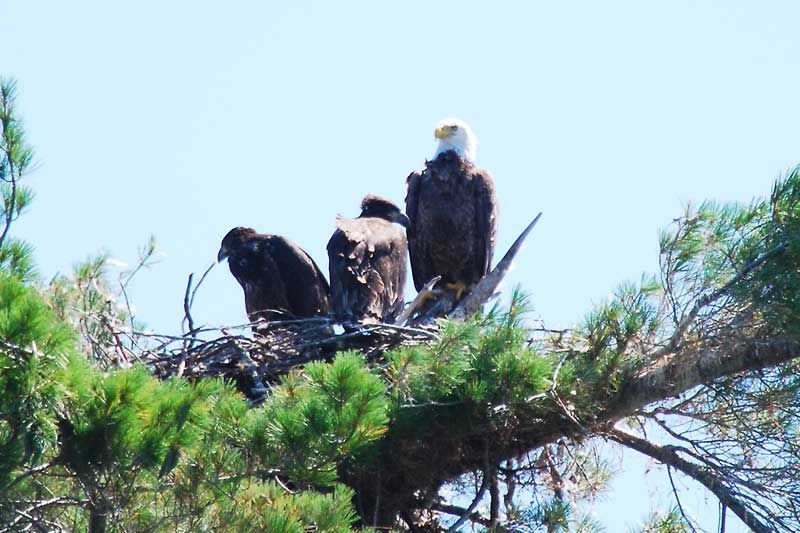Jeff Green | Jul 30, 2014
This nest, which had reportedly been used in the past by Ospreys, has been a good spot for this bald eagle, judging by the size of the young, who should be flying within weeks, or even days. Bald Eagles, which had been almost wiped out in Southern Ontario by 1980, have made a comeback. They are still more common in northwestern Ontario, but nests have been identified on lakes in Frontenac, Lanark, and Leeds and Grenville in recent years.
Bald Eagles are designated as a Species at Risk by the Ontario Ministry of Natural Resources (MNR), but their designation on that list is as a “Species of Special Concern” which is defined by the ministry in the following way: “Lives in the wild in Ontario, is not endangered or threatened, but may become threatened or endangered due to a combination of biological characteristics and identified threats.”
The MNR has four categories of Species at Risk: Extirpated, Endangered, Threatened, and Special Concern. Bald Eagles were listed as Endangered in Southern Ontario in 1980 and have seen steady improvement.
Still, active nests are not common sightings, judging by the number of nests reported in the latest Southern Ontario Bald Eagle Monitoring Program report by Bird Studies Canada in the spring of 2012. That report identified 57 active nest sites in Southern Ontario, the bulk of which are in the vicinity of Lake Erie. Of those, 41 were successful, and 67 chicks survived at least to the fledgling stage (the point when they were able to fly and leave the nest).
That study identified only three nests in Frontenac County, on Bobs, Wolfe and Kashwakamak Lakes, and one in Lanark County, on Christie Lake. The Bobs Lake nest was the only successful one, bringing two chicks to the fledgling stage. There were very likely more successful nests in the two counties in 2011, based on the regular sightings of Bald Eagles each year, but they were either in more obscure locations or they were not reported to Bird Studies Canada.
Marcus Saunders, from Clarendon, an avid bird watcher who did the research in Northern Frontenac and Lanark Counties for the most recent Bird Studies Canada Atlas of Birds of Canada, said that he sees Bald Eagles locally “just about every month of the year.” He said he was aware of a nesting pair on Crotch Lake a number of years ago, and he thinks there may be nests on or near other lakes.
Bud Andress spent 20 years working on the restoration of Bald Eagles in the Thousand Islands region, which included building eagle nesting platforms. He also was part of a team that attached a radio transmitter to six fledgling birds, three of which survived.
“The three birds travelled a spectacular distance. They went as far as James Bay, Labrador, West Virginia and Washington, DC..”
The travel patterns of adult Bald Eagles are not well known, Andress said. There are a number of birds that over-winter in the Thousand Islands region, where their largest food source is white-tailed deer. Unlike Osprey, which survive almost exclusively on fish that they kill themselves, Bald Eagles are opportunistic feeders, happy to steal fish from Osprey or scavenge for food in any way they can.
“What we don't know,” said Andress, “is if the nesting pairs we see in the summer stay here in the winter or travel elsewhere, and we don't know if the pairs stay together all year or just meet up in the breeding grounds in the spring.”
Bald Eagles do nest in the same location year after year, not necessarily in the same nest but in the same vicinity.
One male in the Thousand Islands area where Andress lives has had 37 chicks since 1999, likely with two different mates.
More Stories
- Province clarifies stance - Says Private Well Water Testing Will Continue
- Frontenac County Stays Internal for CAO - Appoints Kevin Farrell
- Addington Highlands Tax Bill Going Up 6.93%
- Perth Road United Church Donation to The Grace Centre
- 21 Years Of Dump Life Left At South Frontenac Waste Site
- Eclipse 2024 – Once In A Lifetime
- National Tourism Week
- NeLL Spring Open House and Anniversary Concert
- 25 years at Bishop Lake Outdoor Centre
- Grounds Contracts Down, Custodial Contracts Up In Central Frontenac

